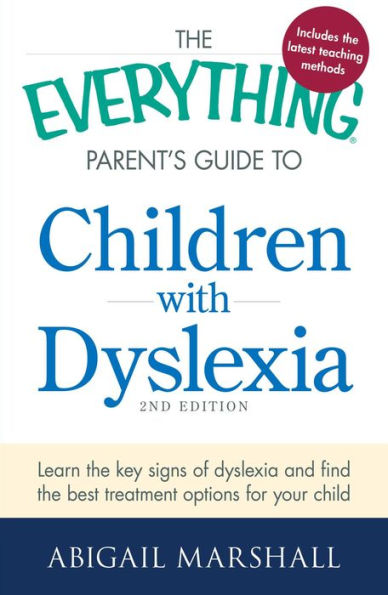
The Everything Parent's Guide to Children with Dyslexia: Learn the Key Signs of Dyslexia and Find the Best Treatment Options for Your Child
304
The Everything Parent's Guide to Children with Dyslexia: Learn the Key Signs of Dyslexia and Find the Best Treatment Options for Your Child
304Paperback
-
PICK UP IN STORECheck Availability at Nearby Stores
Available within 2 business hours
Related collections and offers
Overview
As a parent of a child with dyslexia you may wonder what you should expect as your child goes through life. How can you help your child deal with school and succeed? It's true, there are challenges for children with dyslexia, but when identified early, they can be overcome successfully. Abigail Marshall, manager of dyslexia.com, shows you how to:
- Identify the early symptoms of dyslexia.
- Work with teachers to create an Individualized Education Program (IEP).
- Reduce homework struggles.
- Find the best treatment program.
- Help your child develop skills with the use of assistive technology.
- Plan for college and career.
The Everything Parent's Guide to Children with Dyslexia, 2nd Edition is your first step in facing the challenges of dyslexia with a positive attitude.

Product Details
| ISBN-13: | 9781440564963 |
|---|---|
| Publisher: | Adams Media |
| Publication date: | 08/18/2013 |
| Series: | Everything® Parenting Guide Series |
| Pages: | 304 |
| Sales rank: | 1,132,355 |
| Product dimensions: | 5.50(w) x 8.40(h) x 0.80(d) |
About the Author
Table of Contents
Introduction 13
Chapter 1 Understanding Dyslexia 15
What Is Dyslexia? 15
What Dyslexia Means for Your Child 16
Processing Information 17
History of Dyslexia 19
Defining Dyslexia 20
Different Styles of Learning 22
Genetic Factors in Dyslexia 25
Chapter 2 Characteristics of Dyslexia 27
Early Signs of Dyslexia 27
Your Child's Hearing 31
Your Child's Vision 32
Positive Characteristics of Dyslexia 33
Dyslexia in School-Age Children 34
Dyslexia in Adolescents 39
Chapter 3 Getting a Diagnosis 42
Deciding to Seek Help 42
How Dyslexia Is Diagnosed 46
Tests and Measurements 50
Types of Dyslexia 53
Overlapping and Related Conditions 54
Dyslexia and the Gifted Child 56
Commercial Screening 56
Chapter 4 Related Conditions 58
Problems with Handwriting or Expressive Writing 58
Difficulty with Math 60
"Clumsy Child Syndrome" 62
Attention Deficit Hyperactivity Disorder 63
Nonverbal Learning Disabilities (NLD) 66
Cognitive and Intellectual Delays 67
Mood Disorders 69
Behavioral Disorders 71
Autistic Spectrum Disorders (ASD) 72
Chapter 5 Brain Research and Dyslexia 75
Reading Changes the Brain 75
Physical Brain Differences Associated with Dyslexia 77
Response Time and Filtering Information 80
Pathways to Word Recognition 81
How Brain Activity Influences Reading Skills 84
What Brain Research Means for Your Child 88
Chapter 6 Learning to Read 89
Stages of Reading Development 89
Phonemic Awareness 92
Morphological Awareness 94
Orthographic Knowledge 95
Automaticity and Fluency 96
Comprehension 97
Phonics Versus Whole Language 98
Different Needs of Students with Dyslexia 100
Chapter 7 Specialized Reading Instruction 103
Evidence-Based Instruction 103
Early Preventive Intervention 105
Orton-Gillingham Tutoring 110
Phonics-Based Dyslexia Teaching 114
Developing Advanced Reading Skills 118
The Three-Part Model of Reading 119
Chapter 8 Comprehensive Dyslexia Therapy Programs 122
Choosing a Program 122
Davis Dyslexia Correction 126
Dyslexia Institutes of America 129
Lindamood-Bell Learning Processes 130
Audiblox 133
Cellfield Intervention 135
Fast ForWord Language and Reading Series 136
Chapter 9 Beyond Reading-Therapies for Sensory and Perceptual Challenges 139
Speech, Language, and Occupational Therapy 139
Auditory Integration or Sound Therapy 142
Vision Processing or Sensitivity 144
Brain Training 146
Movement, Rhythm, and Balance 148
Diet and Nutrition 151
Medications to Control Dyslexic Symptoms 155
Chapter 10 Choosing a School 156
Charter, Alternative, or Magnet Schools 156
Private Schools 158
Montessori Schools 159
Waldorf Schools 162
Democratic Schools 163
Specialized Schools for Dyslexia 164
Tax Deductions for Specialized Teaching 167
Chapter 11 IDEA and the IEP Process 168
Qualifying for Services 168
Requesting an Independent Educational Evaluation 170
The Individualized Education Program (IEP) 171
FAPE-Free and Appropriate Education 175
Typical Special Education Services 177
Appeals and Due Process Hearings 178
Payment for Private Services under IDEA 179
Chapter 12 Accommodations and Modifications 182
ADA and 504 Accommodations 182
Suggested Classroom Modifications 183
Assistive Technology 185
Accommodations on Standardized Tests 188
Informal Modifications 190
Taming the Homework Dragon 193
Group Projects 197
Chapter 13 Working with Your Child's Teacher 198
Be the Teacher's Friend 198
Focus on Actual Needs 199
Support the Teacher's Goals 200
Leave the Teacher in Control 201
Building Self-Advocacy Skills 202
Assessment and Grading 204
Dealing with a Problem Teacher 206
Chapter 14 Academic Barriers 210
Speed Contests and Rote Learning 210
School Privileges and Punishments 211
Helping with Organizational Skills 213
Academic Honesty 214
Grade Retention 216
Alternatives to Retention 218
High-Stakes Testing 221
Chapter 15 Teaching Reading at Home 225
Deciding to Homeschool 225
Choosing a Curriculum 228
Motivating Your Child 229
Building Early Literacy Skills 230
Supporting the School-Age Reader 234
Visualization and Reading Comprehension 238
Games and Software to Build Reading Skills 239
Chapter 16 Strategies for Spelling, Writing, and Math 240
Building Visual Memory for Spelling 240
Word Families and Patterns 241
Tips for the Reluctant Writer 242
Understanding Math Concepts 244
Handling Word Problems 247
Specialized Therapies for Math 248
The Paradox of the Math Whiz 249
Chapter 17 Home and Family Issues 252
Effective Communication 252
Chores and Family Responsibilities 254
Behavior and Discipline 255
Sibling Rivalry 257
Sports and Other Activities 259
Rest and Relaxation 261
Chapter 18 The Teenage Years 263
Fostering Independence 263
Taking on New Challenges 265
Accept Your Child 266
Extracurricular Activities 268
Getting a Job 269
Getting a Driver's License 271
Chapter 19 Making Choices in High School and Beyond 274
Choosing a High School 274
The High School Guidance Counselor 278
Foreign Language Learning 279
Barriers to High School Graduation 281
College Entrance Exams 282
Choosing a College 285
Career Planning 288
Appendix: Internet Resources for Dyslexia and Learning 290
Index 298
